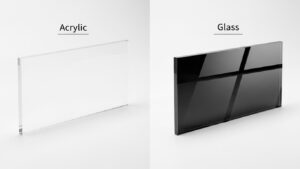Walk into any modern office, event space, salon, or storefront in Cheshire, and you’ll likely spot one thing in common: clean, stylish acrylic signage. Whether it’s a welcoming reception sign, elegant wedding decor, or branding behind a checkout counter, acrylic has become the go-to material for custom signage in the UK.
But here’s the good news: you don’t need to be a fabrication expert to get your own. If you’re wondering how to make acrylic signage, this guide will walk you through everything, from materials and finishes to tips on making your personalized sign stand out.
Materials Needed for Making Acrylic Signage
Before you dive into designing or ordering, you’ll need the right setup. The materials you choose can impact not just the appearance, but also the durability and ease of maintenance.
Here’s what’s typically involved:
- Signage acrylic sheets in your preferred thickness and size (clear, frosted, or coloured)
- A vinyl cutter or laser cutter for shaping and precision detailing
- Self-adhesive vinyl or stencil + acrylic paint for design application
- Transfer tape for precise vinyl positioning
- Microfibre cloth, water, and non-abrasive cleaner to prep and polish your acrylic
- Mounting hardware like standoffs or adhesives, depending on the display type
Want to save time and ensure a flawless finish? Zero Signs UK offers premium, pre-cut acrylic signage, designed and installed for businesses and events across Cheshire. Explore our acrylic sign portfolio and see our latest projects.
Step-by-Step Guide to Making Acrylic Signage
1. Design Your Layout
Use Canva, Illustrator, or professional signage software to create your layout. Consider dimensions, spacing, and font size carefully, especially if it’s intended for customer-facing spaces. If you’re creating a personalised acrylic sign for a wedding or home, you might opt for script fonts, florals, or minimalist outlines.
2. Prepare the Acrylic Surface
Clean your sheet with water and a microfiber cloth. Any dust or residue can trap air beneath your design, leading to visible bubbles or adhesion issues.
3. Apply Your Graphics
If you’re using vinyl wrap, cut your design, remove the negative space (a process known as weeding), and use transfer tape to position it. For paint, use a stencil and high-quality acrylic paint, letting it dry fully between layers.
4. Mount or Frame Your Sign
Use standoffs for a modern wall-mounted look or opt for an acrylic signage circle with rope or chains for event signage. For temporary displays, adhesive strips or tabletop stands work perfectly.
Types of Acrylic Signage
Acrylic signage isn’t one-size-fits-all. From corporate identity to luxury decor, it adapts effortlessly to different settings.
Business Signage
Used indoors or out, acrylic build-up signage and flat wall panels are popular with retailers and office-based businesses. They’re sleek, easy to clean, and instantly elevate brand image.
Event Signage
Custom wedding acrylic signage is trending in Cheshire and across the UK, from welcome boards and table plans to bar menus. Clear or frosted acrylic gives that high-end look with personal flair.
Indoor Decor
From salons and clinics to cafes and coworking spaces, acrylic indoor signage gives your interior a crisp, branded finish. Opt for back-mounted designs or layered effects for added depth.
Maintenance and Care for Acrylic Signs
If you’re investing in signage, whether DIY or professional, you’ll want it to stay looking new. Here’s how to keep it that way:
- Cleaning: Stick to a soft microfiber cloth and gentle soap. Harsh chemicals or rough sponges can cloud or scratch the surface.
- Avoid heat or prolonged sun exposure: While durable, acrylic glass signage can warp or discolour under intense, direct sunlight.
- Storage & Transport: Always use soft padding between signs during transport or storage to avoid friction and scratches.
Displaying Your Acrylic Signage
How you display your sign is just as important as how you make it.
- For a floating effect in modern spaces, wall standoffs create distance and visual interest.
- For small business counters or pop-up shops, easel stands or hanging chain mounts offer flexibility.
- For events or mobile setups, acrylic signage circles hung with rope or satin ribbon create a photo-ready focal point.
Use Cases of Acrylic Signs
A local spa in Cheshire recently worked with our team to create vinyl white wrap lettering on frosted acrylic panels for treatment rooms, offering both style and discretion. The client reported a 30% increase in Instagram engagement thanks to the sign’s aesthetics.
Similarly, a wedding planner used a set of matching acrylic signage circles for a luxury ceremony in Nantwich, each customised with guest names and finished with gold vinyl lettering. The bride loved that the signs doubled as keepsakes for her guests.
Want to explore more? Browse our signage portfolio for custom ideas made in-house.
Create Signs That Speak for You
Personalised signage tells your story, whether it’s for a shopfront, an event, or a workspace. And when it comes to how to make acrylic signage, the possibilities are endless. From choosing the right material to applying crisp graphics, every step helps shape the impression you leave behind.
And if DIY isn’t your style or you need something showroom-ready, we’re here to help. Let Zero Signs UK handle the design, production, and installation with precision and care.
Let’s create something eye-catching together. Contact us for a quote or consultation today.
FAQ: People Also Ask About Acrylic Signage
Does acrylic signage turn yellow over time?
High-quality signage acrylic sheets resist yellowing for years, especially when installed indoors or out of direct UV exposure. All our signage options use premium, fade-resistant materials to ensure longevity and clarity.
Can I make my own sign at home?
Absolutely. Many small business owners and event planners choose to make their own signs using Cricut machines, pre-cut vinyl, or paint. However, for large-scale installs or branding consistency, professional fabrication is a smarter investment.
What’s better: clear, matte, or frosted acrylic?
It depends on where it’s going. Clear acrylic is sleek and modern, ideal for full transparency. Frosted is perfect for privacy or a softer aesthetic, while matte is low-glare and works well under bright lights.





